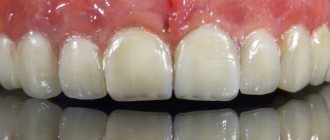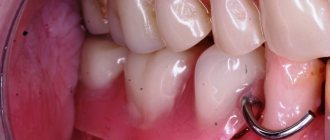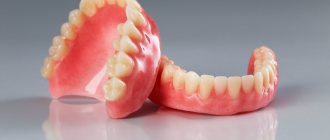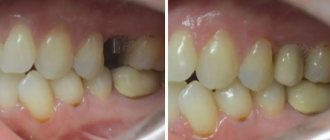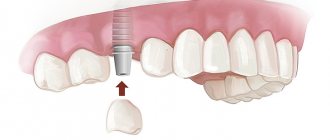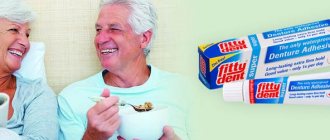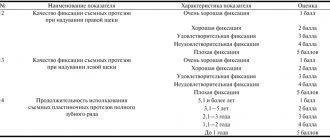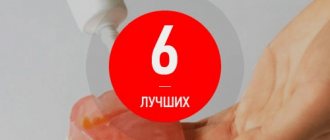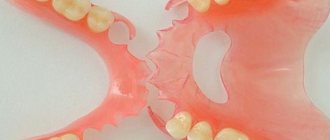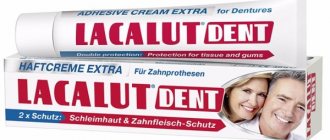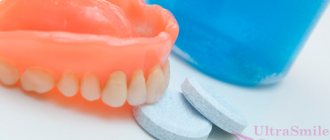Indications for relining Correction methods Relining materials Where to do it?
The basis for comfortable use of removable orthopedic systems is a reliable fit to the jaw. But gradually the fixation of the structure weakens, functionality decreases, and discomfort appears when eating and talking. Relining a denture (partial, complete) – involves eliminating inaccuracies, preventing damage to the base of the structure, restoring precise contact with the gums and supporting dental units. Depending on the clinical case, such a procedure is performed in the dentist’s office or in a laboratory setting.
When is denture relining necessary?
After fixing the new orthopedic system, after the first 1-3 months
wearing, relining the denture is necessary to correct the accuracy of its fit to the mucosa. Because the teeth were missing for some time, the jaw joint was rebuilt. After installing the prosthetic structure, the load on the jaw tissue changes. It begins to gradually atrophy, the gums sag, and the bite begins to change. The prosthesis becomes uncomfortable and the occlusion is disrupted.
Relocation shown:
- if the structure does not hold well in the mouth, falls out during conversation, eating, or puts pressure on the gums;
- in the presence of defects in the prosthetic system due to violations of technology during impression taking or manufacturing;
- deterioration of the aesthetic characteristics of the structure;
- the prosthesis has been damaged or has flaws;
- the shape of the alveolar process has changed, which caused instability of the orthopedic structure;
- an atypical change in the height of the lower part of the face was detected (even if the deviation is minimal from the original parameters).
Correction is needed not only for removable models, but also for conditionally removable structures supported by implants. Mostly, these are single-stage protocols with instant load (all-on-4, all-on-6). After implantation of implants and installation of a prosthetic system, the load on the bone increases. This leads to enhanced regeneration of bone tissue and an increase in its parameters, which requires correction of the orthopedic apparatus. That is, if the bite changes, the position of the prosthetic system changes.
Home care
Your dentist may recommend a denture cleaner.
When cleaning a partial denture, it is recommended to stand on top of a folded towel or drain water in case it is accidentally damaged.
Best materials of the month
- Coronaviruses: SARS-CoV-2 (COVID-19)
- Antibiotics for the prevention and treatment of COVID-19: how effective are they?
- The most common "office" diseases
- Does vodka kill coronavirus?
- How to stay alive on our roads?
It is not recommended to use toothpaste as it may be too harsh for cleaning dental devices.
Some people use hand soap or mild dishwashing liquid to clean them, but these products are not acceptable. However, most homemade cleaners are too abrasive and should not be used on dentures.
It is advisable to brush with a special brush every day to remove food deposits and plaque. It's best to use a brush designed for cleaning dentures because it has bristles that are positioned to conform to the shape of the denture. A regular soft bristle toothbrush is also acceptable.
You should avoid using a brush with hard bristles, which can damage it. The device should be cleaned by thoroughly rinsing loose food particles. You need to wet the brush and apply denture cleaner. Next, gently clean all surfaces of the denture so as not to damage the plastic or bend the attachments. It may lose its proper shape if it is not kept moist. At night, the denture should be placed in a soaking solution or water. The dentist can recommend the proper method to keep the devices in good shape.
It should not be chewed, swallowed or rinsed with dental cleaners and should always be rinsed thoroughly before placing it in the mouth.
Do not use household adhesives because they may contain harmful chemicals and may not be useful for holding a removable partial denture in place.
Correction methods
Relining a complete removable denture, as well as restoring a partial structure, is carried out by two methods - clinical (in the dentist's office) and laboratory. If the design does not fit well enough, the doctor will be able to adjust it in front of the patient; this takes a minimum of time. If there is a significant violation of the fit, or a decrease in the height of the bite, additional equipment will be needed; correction is carried out in a laboratory. How dentures are relined depends on the complexity of the work and the type of prosthetic system.
Clinical method
The procedure includes the following stages of prosthesis relining:
- assessment of bite, occlusion, compliance of the orthopedic design with the jaw relief;
- adjusting the structure, filing edge elements (lengthening, shortening);
- removal of polishing from the orthopedic system, preparation of the polymer mass;
- distribution of the polymer composition onto the treated surface of the prosthesis;
- installation of an orthopedic system for the patient, with complete closure of the teeth of the upper and lower jaw (assessment of central occlusion);
- removal of excess polymer mass from the structure, polymerization of plastic (if there is a metal base, a layer of the corresponding metal is sprayed onto the inner surface of the prosthesis, then a plastic mass is applied to the metal base);
- immersion in hot water for final polymerization, improving adhesion strength;
- modeling of the edge segment, finishing polymerization.
The clinical method allows you to immediately eliminate all shortcomings and achieve a tight fit of the prosthetic system to the gums. The technique is not used in the presence of infectious and inflammatory diseases of the oral mucosa or allergies to plastic.
Laboratory method
Relining the prosthesis base in the laboratory allows you to avoid the negative impact of the plastic composite on the mucous membrane, but you will have to wait several days for the result.
- The doctor assesses the condition of the prosthetic structure, takes an impression of the patient’s teeth and sends everything to the laboratory;
- a thin layer of plastic is removed from the orthopedic system, the polishing is removed from the edge segment;
- the required amount of plastic is applied to the structure, its boundaries are formed, ground, polished, and the closure in the position of central occlusion is checked;
- the finished orthopedic system is returned to the doctor, who installs it for the patient.
Among the advantages of the technique are high aesthetics of the prosthetic system, maximum adhesion of materials (base, relining polymer), and absence of allergies to the plastic composite. Relining plate dentures in the laboratory takes 2 days or more
. There is no adaptation to the adjusted orthopedic device, since the patient has already used it before.
Let's look at the most common reasons for poor fixation of a complete removable denture.
- Most often, the reason is poor fit of the prosthesis to the gum (prosthetic bed). This may be a consequence of poor quality (accurate) manufacturing, or prolonged use of the prosthesis. In this case, a gap appears between the prosthesis and the gum, air gets in there and the prosthesis “falls off.”
- The second reason for poor fixation of a removable denture is severe atrophy of the jaw bone tissue. With significant atrophy, the relief of the bone tissue becomes almost flat, which in itself makes it difficult to fix the prosthesis (it has “nothing to catch on” with a flat prosthetic bed). In addition, with bone atrophy, the muscles of the oral cavity are located closer to the prosthesis and during work (smiling, chewing or talking) contribute to “throwing off the prosthesis.”
Photo 3.1. Poor conditions for fixing a removable denture: severe atrophy of the jaw ridge, high attachment of the lip muscles.
What can I do to ensure that my removable denture stays in place well?
Method No. 1:
The easiest option is to purchase a special cream for fixing dentures. TV often shows commercials for various gels for fixing dentures, which instantly make their owners happy. Such “glue,” of course, can improve fixation to a certain extent, but according to patient reviews, this method has a number of disadvantages. For example, sticking of “glue” residues to the gums after removing the prosthesis, complicating the cleaning of the prosthesis, which must be done every day in the morning and evening. Well, and most importantly, such a cream does not guarantee a 100% result (although it is much better than nothing).
Today there is a wide variety of dental creams for fixing dentures: Corega, Protefix, Lacalut Dent, Fittident, President, Dentipur, ROCS
In any case, if you use such a cream/gel, you should follow certain recommendations:
Rules for using creams and gels for fixing dentures:
- Apply the cream only to a dry and clean surface of the prosthesis
- the amount of cream should be small, otherwise you can achieve the opposite effect and worsen the fixation
- the denture is pressed tightly against the gum for 15-20 seconds
- After fixing the prosthesis, you need to refrain from eating and talking for 20 minutes
- do not use the cream more than once a day
- After removing the prosthesis, thoroughly clean the prosthesis from any remaining cream.
Method number 2:
If the cause of weak fixation is poor fit of the prosthesis, but the service life of the prosthesis has not been exhausted, the artificial teeth have not been worn out and satisfy functional and aesthetic requirements, then it is possible to “reanimate” it. The doctor’s task is to make sure that the prosthesis fits very tightly to the gum and suctions well. This will require a procedure called denture relining . The essence of relining is to close the gap between the prosthesis and the gum with special plastic, which is layered onto the prosthesis from the inside. Relining can be “clinical”, when the doctor adds plastic to the prosthesis in one visit directly in the dental chair, and “laboratory”. When carrying out laboratory relining, the orthopedic doctor takes an impression along with the prosthesis and transfers it to the dental laboratory, where the dental technician “refines” the prosthesis. After these manipulations, the prosthesis begins to perfectly fit the prosthetic bed and “holds” much better.
Method number 3:
In case of bone tissue atrophy, simple relining of a removable denture is not enough. To improve the fixation of a removable denture, additional supporting and retaining elements are required - dental implants.
Besides, we (the patient and the doctor) want more! I would like the prosthesis to hold even better, and to be smaller in size. Is it possible?
Yes! Maybe! And this will not require any extra effort or global financial investments.
Types of relining material
Correction of removable laminar dentures involves the use of the following materials:
- Hard plastic
– cold-curing acrylics (Protacryl, Redont), hot-curing acrylates (Ethacryl, Ftorax, etc.), polymethyl methacrylate. Solid base plastics are used for rigid fixation of orthopedic systems or laboratory relocation. - Soft composites
– acrylic, silicone elastomers. It is used if the physical parameters of the orthopedic device are normal, but the patient experiences headaches and discomfort. Typically used for relining mandibular prosthetic structures. - Temporary elastics
(conditioners) – polyvinyl chlorides and silicone base materials are highly elastic and are used for soft relining of dentures in case of systematic inflammation of the gums. Elastic materials are characterized by particular softness and are intended to reduce and uniformly redistribute chewing pressure to sensitive areas of the mucosa. Temporary material should be regularly updated, as it reacts negatively to cleaning agents and is susceptible to the accumulation of bacterial plaque.
The cost of relining an orthopedic system depends on several parameters - the technology used, material, type (clasp, conditionally removable, removable), size of the prosthesis, etc.
How to do this without a doctor?
A first aid remedy can be KAMISTAD GEL, produced in Germany, anesthetizes the wound, as it contains lidocaine. It also promotes healing.
Solcoseryl is a dental adhesive paste that promotes wound healing and relieves pain, made in Switzerland.
If you do not have the opportunity to sharpen a removable denture, METROGYL DENTA, made in India, has an antiseptic and ANTI-MICROBIAL effect.
It is possible to combine KAMISTAD + METROGYL DENTA or SOLCOSERYL + METROGYL DENTA
If in a removable denture you find and remove as quickly as possible, sharpen the part that is pressing, then ANESTHEATH and ANTIMICROBIAL components will not be needed.
As a rule, even the most severe cuts in the cavity heal quickly once the cause of the injury is eliminated!
Where to contact
Patients with removable orthopedic devices are recommended to see an orthopedist every 6 months
for relocation of the structure. This must be done for preventive purposes, since due to a violation of the fixation of the orthopedic system in the mouth, breakage of the structure, rapid loosening and loss of supporting teeth (with partial structures) may occur.
To restore a prosthesis in Moscow, it is most convenient to contact the RUTT network of clinics. Relining is carried out using modern cushioning materials from reliable manufacturers, which guarantees precise fit of the restored structure, uniform distribution of the chewing load, and long service life.
Expert of the article Alekperov Roman Borisovich Dentist-orthopedist, doctor of the first category
Work experience24 years
Indications for adjustments
- reduction in the volume of gingival tissue, resulting in exposure of the root tips;
- shortened teeth;
- unequal gum size;
- the presence of large gum pockets and their peeling from the surface of the dental unit;
- an inflammatory process that results in swelling and soreness of the soft tissues.
Contraindications:
- the presence of diabetes mellitus in the patient;
- period of reduced blood clotting;
- weak immunity;
- acute infectious diseases;
- cardiovascular diseases;
- patient intolerance to the anesthetic substance.
Materials for removable dental prosthetics
Materials used for the manufacture of dentures in dentistry “Zubastic”:
- Acrylic – dentures made from acrylic plastic are strong and durable.
- Nylon is an elastic, flexible and lightweight material. A nylon product is more comfortable to wear, but the soft texture does not provide an even chewing load.
- Acry-free is a modern option that combines the flexibility of nylon and the strength of acrylic. Products made from it are comfortable and aesthetically pleasing.
The specialist will select the material and method of fastening individually, taking into account the existing defect, jaw structure and other factors.
Symptoms that require immediate medical attention
Dentures can be uncomfortable from the start. This may be caused by its incorrect manufacture, or simply by discomfort caused by the appearance of a foreign object in the oral cavity. In the first days, it is strongly recommended not to remove the structure so that you can get used to it, so that all the mucous membranes adapt. But if the pain intensifies, the gums become inflamed and it is really impossible to wear a denture, you should consult a doctor.
System correction is also necessary in the following situations:
- Bite disturbances occur when the jaws are closed, regardless of how many dentures are installed - only on one jaw or on both jaws at once,
- It’s impossible to chew with new teeth – it’s uncomfortable and even painful,
- ulcers form on the gums under the structure, the gums bleed,
- there is continuous and painful contact of the prosthesis with the mucous membranes - the inside of the lips and cheeks,
- the structure does not hold, it shifts under load,
- burning of the mucous membrane, severe dry mouth, rash in the oral cavity.
Sections
- What is removable dental prosthetics?
- Indications and contraindications for the procedure
- Materials for removable dental prosthetics
- Types and prices of removable dental prosthetics
- Stages of complete removable dentures
- Equipment of dental clinics "Zubastic" for removable dental prosthetics
- Advantages of removable dental prosthetics in our clinic
- Registration for removable dental prosthetics in Moscow
- Types of removable prosthetics
Types and prices of removable dental prosthetics
The main types of prosthetics in dentistry “Zubastic”:
- “ Butterfly ” - the prosthesis replaces 1-2 missing units.
- Removable denture (partial) - recommended for incomplete edentia. This design prevents mobility and displacement of the remaining teeth and ensures chewing function.
- Complete removable dentures on implants are the latest method of restoring lost teeth. Implants serve as support for the plate prosthesis. The method is used for complete edentia. Strengthening (fixation) of the bridge occurs due to spherical abutments. The patient can independently remove the prosthesis for hygiene procedures.
- The clasp is a structure on a metal frame to which a base with artificial teeth is welded. This is one of the best options for removable dentures, which evenly distributes the chewing load, is characterized by increased strength and comfort of use.
The price for removable dental prosthetics in Moscow at Zubastik clinics is low. The doctor will suggest an option for restoring the dentition after examining and assessing the condition of the remaining teeth.
